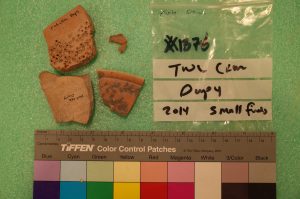ACOR cannot thrive without the help of great interns – they are often current university students and recent graduates from the U.S. and Jordan. Safa’ Joudeh and Libby Trowbridge worked together as a great intern team to help document a large number of objects excavated and sifted from the Temple of the Winged Lions (TWL), a majestic complex built by the Nabataeans during the first century A.D. in Petra. From pictures of rose-colored sandstone to academic texts and pop-culture references, Petra’s powerful allure attracts tourists and interns alike. Here they write about their journey and experience within archaeology and heritage.

For Safa’, her first time learning about ACOR’s Temple of the Winged Lions Cultural Resource Management (TWLCRM) Initiative was two and a half years ago. She was in her fourth year of architecture school, sitting in a dark room listening to her professor explain a reconstruction method that had been used in the temple. She cites this moment as the start of her interest in both TWL and the archaeological field. For Libby, her first knowledge of Petra was through the flashy study abroad brochures passed around her university in the United States. The advertisements claimed that studying abroad in Amman was the prime opportunity to visit the ancient archaeological city in southern Jordan. Upon arriving in Amman, she soon discovered TWL through ACOR’s website and lecture series.
Together, Libby and Safa’ have been working with Dr. Jack Green of ACOR to process and document materials from the TWL excavation. Each day, the interns handle many pieces of pottery, glass, bone, stone, painted plaster, beads, and coins that have been retrieved from the sifted soil dumps surrounding the temple. Libby and Safa’ are responsible for identifying, photographing, and measuring the objects, to be assessed in the future as the TWL moves into a research and publication phase. The rapid documentation of material will help assess the wide range of material that was not collected by the American Expedition to Petra during that earlier mission. Their constant contact with two thousand-year old remnants of Petra has given them both an appreciation of the temple and the Nabataean kingdom. “One of the things that amazes me the most,” said Safa’, “is trying to connect the objects with life at the site in the past…including the functions of every part and room in the temple. From the thicknesses of the pottery pieces as well as the different types of stone, to the slag and bones, [everything] has made me more conscious and aware of archaeological work.” According to Libby, every piece has a different story to tell. She said, “pieces of worked stone and shell fragments suggest there was a workshop in the temple area…We never know what to expect until we open the bag and take its contents out.”

The culmination of Libby and Safa’s internship was in November 2018 when the interns attended an ACOR-sponsored visit to Petra. Safa’ was responsible for photographing and drawing sections of the temple’s northernmost wall, while Libby distributed surveys to visiting tourists. During their time on site, the interns talked to visitors from around the world—Austria, Canada, Denmark, England, Taiwan—about their experience at TWL and Petra. “It was neat to see so many people from different places gathered in Petra,” said Libby, “It really highlights Petra’s significance as a point of cultural and historical pride to the Jordanian people.”
TWLCRM has worked diligently to support the local community. The initiative has created job opportunities for over 700 people over several years, especially with women and youth in Petra’s nearby Bedouin communities. In previous years, local women sewed burlap bags together that were filled with soil sifted from the dump sites. They then stacked the bags against key sections of the temple’s walls to stabilize the area. Many of the 1,700 objects Libby and Safa’ documented have been pulled directly from the soil the women sifted to fill these sandbags.

After the internship, Safa’ will continue pursuing archaeological work in Jordan and Libby will return to the United States. Despite their different paths, both young women will take with them the memory of TWL for the rest of their lives. Safa’ has already reflected on how her experience in Petra has been shaped by TWL. “This year’s visit to the temple was really different from last year,” She says, “I had a different level of understanding. Dr. Green walked me around the site [and] explained the nature and the function of every part of it.” Thanks to ACOR, both interns have a deeper insight into the temple, its inhabitants, and its contents. According to Libby, “When I found out I was going to Jordan, one of my professors congratulated me and told me I absolutely had to visit Petra. When I go back, I’ll be sure to tell him I saw everything imaginable both above and below the ground.”
Learn more about the TWLCRM Initiative, and consider supporting ACOR’s ongoing, vital conservation work at the Temple of Winged Lions

Safa’ Joudeh graduated from the Hashemite University in June 2018 with a degree in Architectural Engineering. She is interested in reuse and renovation of heritage and archaeological sites. Previously, she helped create digital 3D reconstructions of Roman period statues recently unearthed at Jerash. Safa’ joined ACOR as an intern in fall 2018 in support of the Temple of the Winged Lions Cultural Resource Management (TWLCRM) Initiative.
Libby Trowbridge is a double major student in Arabic and International Relations at the University of Oklahoma. She is interested in history, archaeology, and Middle Eastern studies. Libby joined ACOR as an intern in fall 2018 in support of the Temple of the Winged Lions Cultural Resource Management (TWLCRM) Initiative.
